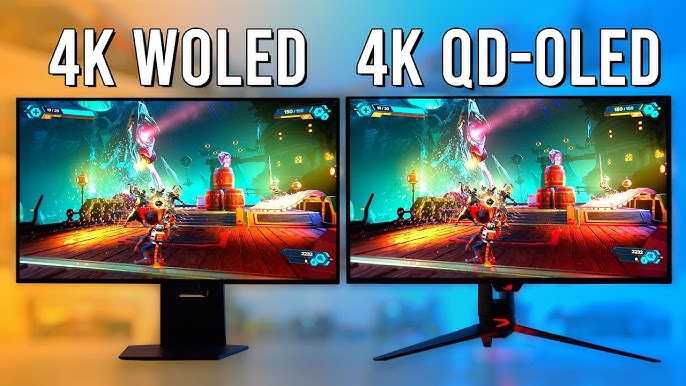HDR monitors often outperform OLED screens in specific aspects like brightness and color accuracy, but whether they are “better” depends on what you’re looking for. For general use, HDR monitors excel in delivering vibrant visuals, especially for gaming and HDR content, while OLED screens are prized for their perfect blacks and superior contrast. If you seek dazzling, bright images with an emphasis on detail in highlights, HDR monitors might be your best choice; for immersive contrast and deep blacks, OLEDs shine brighter. Ultimately, it’s about your specific needs—both display types have their unique advantages.
HDR monitors and OLED screens each bring distinct strengths, making them suitable for different users. HDR monitors are typically brighter and better for multitasking and gaming, while OLED displays provide unmatched contrast and color richness, perfect for media consumption and creative work. In the debate of which is better, it hinges on your priorities—vivid brightness or deep contrast. In this article, we’ll explore the key differences and help you decide which display type suits you best.
When it comes to choosing between HDR monitors and OLED screens, understanding what each offers is crucial. HDR monitors are designed to deliver high dynamic range content with increased brightness and color detail, making them ideal for watching movies, gaming, and working with HDR images. OLED screens, on the other hand, feature self-emitting pixels that produce perfect blacks and exceptional contrast ratios, creating a deeply immersive visual experience. Both options have seen technological advancements, but your choice will depend on whether you prioritize brightness and versatility or contrast and image depth. Let’s delve deeper into their strengths and weaknesses to help you make an informed decision.
Are HDR Monitors Better Than OLED? An In-Depth Comparison
Understanding HDR Monitors and OLED Displays
HDR monitors and OLED screens are both popular choices for vibrant visuals. HDR stands for High Dynamic Range, which allows monitors to display a broader spectrum of colors and brightness levels. OLED, or Organic Light Emitting Diode, refers to a display technology that uses organic compounds to produce light directly.
Brightness and Contrast Capabilities
HDR monitors typically offer higher peak brightness levels, often reaching 1000 nits or more. This means scenes with bright highlights, like sunlight or explosions, appear more vivid. OLED screens excel in contrast because each pixel can turn on or off independently, creating true blacks and bright whites simultaneously.
The Role of Brightness in Visual Quality
High brightness levels in HDR monitors enhance the impact of HDR content, especially in well-lit rooms. OLED displays, while having excellent contrast, might struggle to reach the same peak brightness, which can limit HDR effects in certain scenarios.
Contrast Ratios and Black Levels
OLED screens produce perfect black levels because pixels can turn completely off. HDR monitors often achieve high contrast through local dimming zones, but they may not match the absolute black levels of OLED. This difference can influence image depth and realism.
Color Accuracy and Gamut
Both HDR monitors and OLED displays support wide color gamuts, but OLED panels often provide better color accuracy out of the box. This makes images look more natural and true to life. Additionally, OLED’s ability to produce very saturated colors benefits vivid scenes and gaming.
Color Depth and Reproduction
HDR monitors commonly support 10-bit color depth, enabling smoother gradients and reducing color banding. OLED screens also support deep color depths, ensuring high fidelity in complex images.
Response Time and Refresh Rate
For fast-paced activities like gaming or video editing, response time and refresh rate matter. OLED displays usually have faster response times, which reduces motion blur and ghosting effects. Many HDR monitors now offer high refresh rates, but OLED still has an edge in speed.
Impact on Gaming and Motion Clarity
High refresh rates combined with quick response times on OLED panels provide smoother visuals during rapid movements. HDR monitors with high refresh rates can also deliver good performance but may have slightly higher latency.
Viewing Angles and Screen Uniformity
OLED screens generally maintain consistent color and contrast across wide viewing angles. HDR monitors may experience color shifts or contrast loss when viewed from the side, especially in cheaper models. This makes OLED preferable for multi-user environments.
Uniformity and Color Consistency
OLED displays tend to have excellent uniformity, while some HDR monitors might show backlight bleed or uneven brightness, affecting the overall experience.
Longevity and Burn-In Risks
One concern with OLED technology is the potential for burn-in, where static images leave permanent marks over time. HDR monitors do not face this problem. However, modern OLED panels have mitigated burn-in risks through software features.
Durability and Maintenance
HDR monitors are generally more durable and require less maintenance, making them suitable for various environments. OLED screens need careful usage to prevent ghosting or burn-in, especially in static content display.
Price and Value for Money
OLED displays tend to be more expensive due to their advanced technology and superior contrast features. HDR monitors offer a more affordable option with high brightness levels and good color reproduction.
Cost Comparison and Features
| Feature | HDR Monitors | OLED Displays |
|———|—————-|————–|
| Price Range | $300 – $1500 | $800 – $3000 |
| Brightness | Up to 2000 nits | 600 – 1000 nits |
| Black Levels | Deep but not perfect | Perfect blacks |
| Response Time | Moderate to high | Very fast |
| Viewing Angles | Good but limited in cheaper models | Wide and consistent |
Application Suitability and Use Cases
Choosing between HDR monitors and OLED depends on your specific needs. For professional photo and video editing, color accuracy and contrast are vital, making OLED a strong choice. For gaming or general multimedia, high-brightness HDR monitors can deliver excellent image quality at a more affordable price.
Best for Content Creators and Photographers
OLED’s superior color accuracy and contrast make it ideal for editing high-quality images and videos. It provides true-to-life visuals necessary for professional work.
Best for Gamers and Home Entertainment
High refresh rates and quick response times are crucial for gamers. OLED’s fast response time reduces motion blur, providing a smoother gaming experience.
Impact of Environmental Conditions
Ambient lighting affects display visibility. HDR monitors with higher brightness can combat glare more effectively, while OLED screens maintain clarity in darker environments. Consider your typical viewing environment when choosing.
Viewing Experience in Different Settings
In bright rooms, HDR monitors’ high brightness outperforms OLED. Conversely, in dimly lit rooms, OLED’s contrast and black levels shine, creating a more immersive experience.
Future Trends and Technology Developments
The evolution of display technology continues, with OLED improving in brightness and lifespan. HDR monitors are also advancing with better local dimming and wider color gamuts, narrowing the gap between the two options.
Emerging Innovations
OLED panels are becoming more affordable and offering higher durability. HDR standards are evolving, ensuring better compatibility and performance.
When deciding whether HDR monitors are better than OLED, consider your priorities like contrast, brightness, price, and intended use. OLED displays excel in contrast, color accuracy, and viewing angles, but HDR monitors often provide higher brightness and affordability. Both types have unique advantages, making the best choice highly dependent on your specific needs and budget.
1440p OLED or 4K Monitor for Gaming?
Frequently Asked Questions
What are the key differences between HDR monitors and OLED displays?
HDR monitors typically use LED or LCD technology combined with high dynamic range capabilities to produce more vivid images with better contrast and color depth. OLED displays, on the other hand, consist of organic light-emitting diodes where each pixel emits its own light, allowing for true blacks and exceptional contrast ratios. While HDR enhances the display’s dynamic range, OLED technology inherently provides superior contrast and color accuracy due to its self-emissive pixels.
How does brightness performance compare between HDR monitors and OLED screens?
HDR monitors often achieve higher peak brightness levels, making highlights appear more striking and vibrant, especially in well-lit environments. OLED screens can reach impressive brightness levels but generally have a lower peak compared to high-end HDR monitors. However, OLED displays excel in delivering perfect blacks and maintaining contrast at various brightness levels, which enhances image quality in darker scenes.
Which display type offers better color accuracy and uniformity in real-world usage?
OLED displays typically provide superior color accuracy thanks to their self-emitting pixels, which can produce a wider color gamut and consistent color reproduction across the screen. They also maintain uniformity better, as each pixel produces light independently, eliminating issues like backlight bleed. HDR monitors can deliver excellent color performance, but they may sometimes exhibit uneven brightness or color shifts depending on the panel quality.
What are the common drawbacks of HDR monitors compared to OLED panels?
HDR monitors can be limited by lower contrast ratios and less perfect black levels because they rely on LCD or LED backlighting. They are often bulkier, require more power, and may experience issues like blooming or light bleed. OLED screens, in contrast, can suffer from image retention or burn-in over time, especially with static images, and tend to be more expensive upfront.
In terms of gaming and multimedia consumption, which display type provides a better experience?
For gaming and multimedia, OLED displays offer stunning visuals with deep blacks, vibrant colors, and high contrast, which create an immersive experience. Their fast response times and wide viewing angles improve gameplay. HDR monitors, however, can produce brighter highlights and are often more affordable, making them a solid choice if high peak brightness is a priority. Ultimately, your preference depends on whether you value contrast and color precision or brightness and affordability.
Final Thoughts
HDR monitors often provide vibrant colors and better contrast, making them ideal for professional editing and immersive gaming. OLED screens offer perfect blacks and uniformity, creating stunning visual experiences.
However, HDR monitors excel in brightness and compatibility with various devices, while OLEDs face issues like burn-in and limited brightness.
In conclusion, are hdr monitors better than oled? It depends on your priorities. For vivid visuals and versatility, HDR monitors stand out, but OLEDs deliver unmatched picture quality.

I follow the latest trends in smart devices, portable monitors, and gaming accessories. My goal is to provide real-world insights that help readers make smarter tech decisions.





